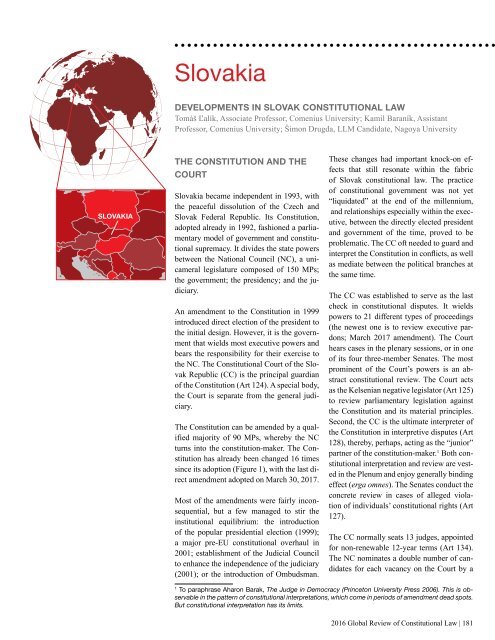2016 Global Review of Constitutional Law
I-CONnect–Clough Center collaboration.
I-CONnect–Clough Center collaboration.
Create successful ePaper yourself
Turn your PDF publications into a flip-book with our unique Google optimized e-Paper software.
Slovakia<br />
DEVELOPMENTS IN SLOVAK CONSTITUTIONAL LAW<br />
Tomáš Ľalík, Associate Pr<strong>of</strong>essor, Comenius University; Kamil Baraník, Assistant<br />
Pr<strong>of</strong>essor, Comenius University; Šimon Drugda, LLM Candidate, Nagoya University<br />
SLOVAKIA<br />
THE CONSTITUTION AND THE<br />
COURT<br />
Slovakia became independent in 1993, with<br />
the peaceful dissolution <strong>of</strong> the Czech and<br />
Slovak Federal Republic. Its Constitution,<br />
adopted already in 1992, fashioned a parliamentary<br />
model <strong>of</strong> government and constitutional<br />
supremacy. It divides the state powers<br />
between the National Council (NC), a unicameral<br />
legislature composed <strong>of</strong> 150 MPs;<br />
the government; the presidency; and the judiciary.<br />
An amendment to the Constitution in 1999<br />
introduced direct election <strong>of</strong> the president to<br />
the initial design. However, it is the government<br />
that wields most executive powers and<br />
bears the responsibility for their exercise to<br />
the NC. The <strong>Constitutional</strong> Court <strong>of</strong> the Slovak<br />
Republic (CC) is the principal guardian<br />
<strong>of</strong> the Constitution (Art 124). A special body,<br />
the Court is separate from the general judiciary.<br />
The Constitution can be amended by a qualified<br />
majority <strong>of</strong> 90 MPs, whereby the NC<br />
turns into the constitution-maker. The Constitution<br />
has already been changed 16 times<br />
since its adoption (Figure 1), with the last direct<br />
amendment adopted on March 30, 2017.<br />
Most <strong>of</strong> the amendments were fairly inconsequential,<br />
but a few managed to stir the<br />
institutional equilibrium: the introduction<br />
<strong>of</strong> the popular presidential election (1999);<br />
a major pre-EU constitutional overhaul in<br />
2001; establishment <strong>of</strong> the Judicial Council<br />
to enhance the independence <strong>of</strong> the judiciary<br />
(2001); or the introduction <strong>of</strong> Ombudsman.<br />
These changes had important knock-on effects<br />
that still resonate within the fabric<br />
<strong>of</strong> Slovak constitutional law. The practice<br />
<strong>of</strong> constitutional government was not yet<br />
“liquidated” at the end <strong>of</strong> the millennium,<br />
and relationships especially within the executive,<br />
between the directly elected president<br />
and government <strong>of</strong> the time, proved to be<br />
problematic. The CC <strong>of</strong>t needed to guard and<br />
interpret the Constitution in conflicts, as well<br />
as mediate between the political branches at<br />
the same time.<br />
The CC was established to serve as the last<br />
check in constitutional disputes. It wields<br />
powers to 21 different types <strong>of</strong> proceedings<br />
(the newest one is to review executive pardons;<br />
March 2017 amendment). The Court<br />
hears cases in the plenary sessions, or in one<br />
<strong>of</strong> its four three-member Senates. The most<br />
prominent <strong>of</strong> the Court’s powers is an abstract<br />
constitutional review. The Court acts<br />
as the Kelsenian negative legislator (Art 125)<br />
to review parliamentary legislation against<br />
the Constitution and its material principles.<br />
Second, the CC is the ultimate interpreter <strong>of</strong><br />
the Constitution in interpretive disputes (Art<br />
128), thereby, perhaps, acting as the “junior”<br />
partner <strong>of</strong> the constitution-maker. 1 Both constitutional<br />
interpretation and review are vested<br />
in the Plenum and enjoy generally binding<br />
effect (erga omnes). The Senates conduct the<br />
concrete review in cases <strong>of</strong> alleged violation<br />
<strong>of</strong> individuals’ constitutional rights (Art<br />
127).<br />
The CC normally seats 13 judges, appointed<br />
for non-renewable 12-year terms (Art 134).<br />
The NC nominates a double number <strong>of</strong> candidates<br />
for each vacancy on the Court by a<br />
1<br />
To paraphrase Aharon Barak, The Judge in Democracy (Princeton University Press 2006). This is observable<br />
in the pattern <strong>of</strong> constitutional interpretations, which come in periods <strong>of</strong> amendment dead spots.<br />
But constitutional interpretation has its limits.<br />
<strong>2016</strong> <strong>Global</strong> <strong>Review</strong> <strong>of</strong> <strong>Constitutional</strong> <strong>Law</strong> | 181


